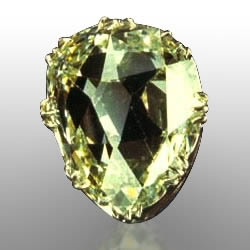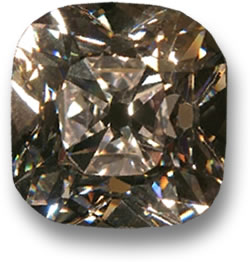Famous Crown Jewels: The Sancy Diamond

Introduction to the Sancy Diamond
The Sancy Diamond, often called the Sancy Stone, is one of history’s most celebrated gems. This pale yellow diamond, weighing 55.23 carats, has a storied past, passing through the hands of kings, queens, and nobles. Rumored to carry a curse, it was once believed to grant invincibility to its wearer - a legend that’s more myth than fact, but boy, does it make for a good story! What sets the Sancy apart is its unique pear-shaped cut, with no pavilion and two crowns stacked atop each other. It was also one of the first large diamonds to boast symmetrical facets, a groundbreaking feat in gem cutting for its time. For more details on such properties, explore our comprehensive guide to diamond gemstone information. Let’s dive into its journey, starting with its murky origins.
Origins and Early History
Where did this dazzling gem come from? Some say the Sancy Diamond hails from Persia, possibly owned by the Mughal Empire, while others argue its unusual cut points to India. The debate’s still open, but what we do know is that it first popped up in historical records with Charles the Bold, Duke of Burgundy, who reportedly lost it during a battle in 1477. Talk about a rough day on the battlefield! By 1570, the diamond landed in the hands of Nicolas de Harlay, Seigneur de Sancy, a French ambassador and gem enthusiast. Harlay, ever the savvy collector, bought the stone in Constantinople, using it to boost his status among French nobility.
The Sancy in French Royalty
Fast forward to France under Henry III, who was dealing with a personal crisis - hair loss. To distract from his thinning crown, he borrowed the Sancy from Harlay and sported it as a hat decoration. Diamonds were all the rage, and Henry wasn’t about to miss out. When Henry IV took the throne, the Sancy took on a new role: funding his army. He entrusted a loyal servant to deliver the gem as collateral for troops, but the messenger vanished. Foul play was suspected until an autopsy revealed the diamond in the servant’s stomach - talk about loyalty! The servant had swallowed it to protect it before his death.
English Royalty and the Sancy
In 1605, Nicolas de Harlay sold the diamond to King James I of Scotland, officially naming it “The Sancy.” It was cataloged in the Tower of London’s Jewel Inventory as “one fayre dyamonde, cut in fawcetts, bought of Sauncy.” The gem became a royal favorite, often worn as a jeweled pin. But its supposed invincibility didn’t save King Charles I, who owned it before his execution. The Sancy then passed to the Earl of Worcester and later to King James II. After losing the Battle of Boyne in 1690, James II fled to France and, strapped for cash, sold the diamond to Cardinal Mazarin for a mere £25,000.
The Sancy’s Later Journey
The Sancy stayed in France until 1792, when it was stolen from the Royal Treasury alongside the Regent and Hope Diamonds. It vanished from public view until 1828, when Russian Prince Anatole Demidoff bought it for £88,000. After his death, it was sold to Indian Prince Sir Jamsetjee Jeejeebhoy for around £100,000. The diamond’s trail goes cold here, with its next buyer and price a mystery. It’s like the Sancy was playing hide-and-seek with history!

The Sancy in the Modern Era
The Sancy resurfaced at the 1867 Paris Exposition, flaunting a 1-million-franc price tag. By 1906, William Waldorf Astor, 1st Viscount Astor, purchased it as a wedding gift for his son’s bride, Lady Nancy Astor, who wore it in her tiara for state occasions. The gem stayed with the Astor family until 1978, when the 4th Viscount Astor sold it to the Louvre for $1 million. Today, you can see the Sancy sparkling in the Louvre’s Apollo Gallery, right next to the Regent Diamond, a fitting home for such a legendary gem.
Frequently Asked Questions
What is the Sancy Diamond?
The Sancy Diamond is a 55.23-carat pale yellow diamond, famous for its pear-shaped cut and lack of a pavilion. It’s one of history’s most renowned gems, owned by various royals.
Where did the Sancy Diamond originate?
Its origins are debated, with some suggesting Persia and others India, based on its unique cut. Its earliest recorded owner was Charles the Bold in 1477.
Is the Sancy Diamond cursed?
Legends claim the Sancy carried a curse, with tales of misfortune for its owners, like Charles the Bold’s battle loss. These are myths, not supported by evidence, similar to stories surrounding other legendary cursed diamonds.
Where is the Sancy Diamond today?
The Sancy Diamond is housed in the Louvre Museum in Paris, displayed in the Apollo Gallery alongside the Regent Diamond.
Disclaimer: This article mentions beliefs about the Sancy Diamond granting special powers, such as invincibility. These claims are historical myths and legends, not supported by scientific evidence. Gemstones do not possess healing or spiritual properties.

